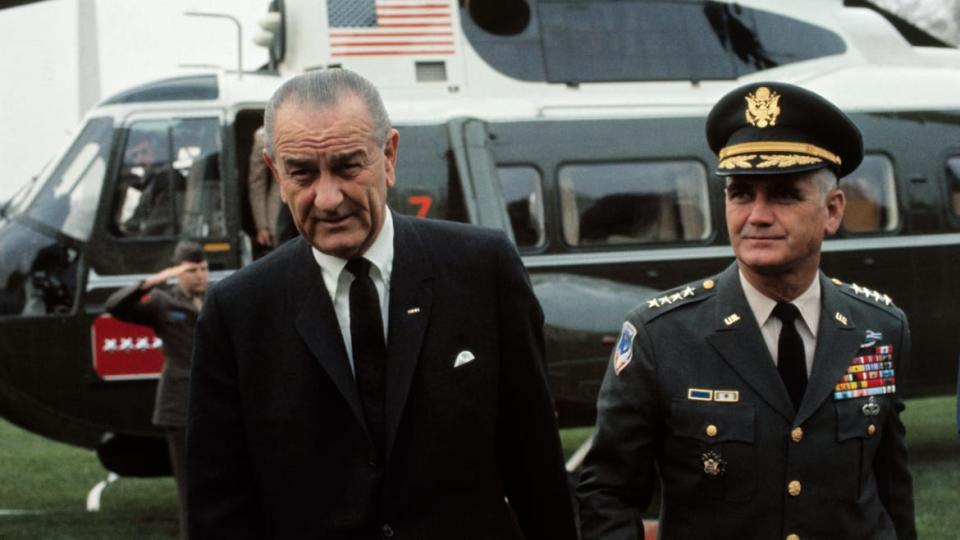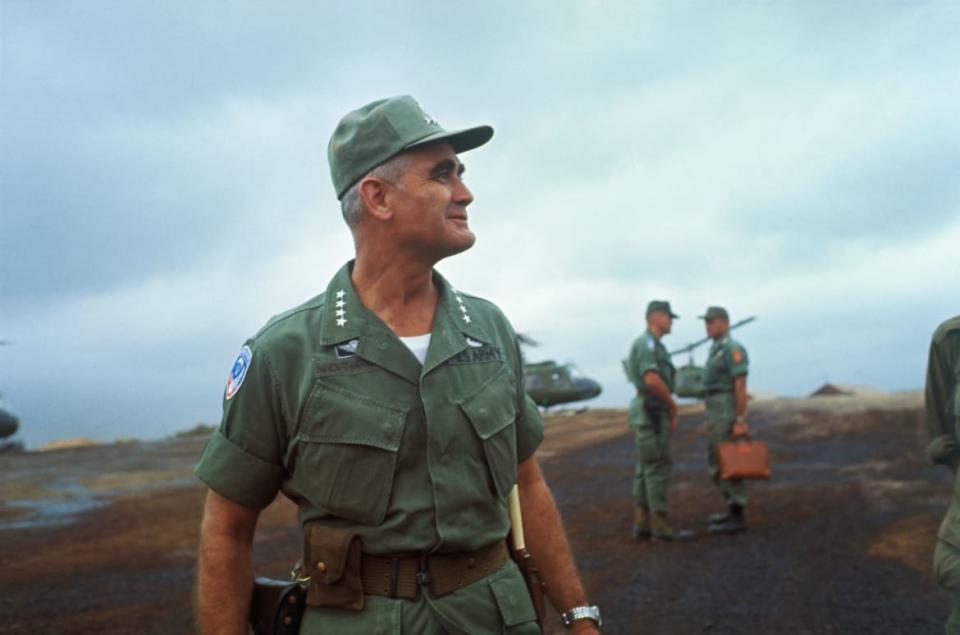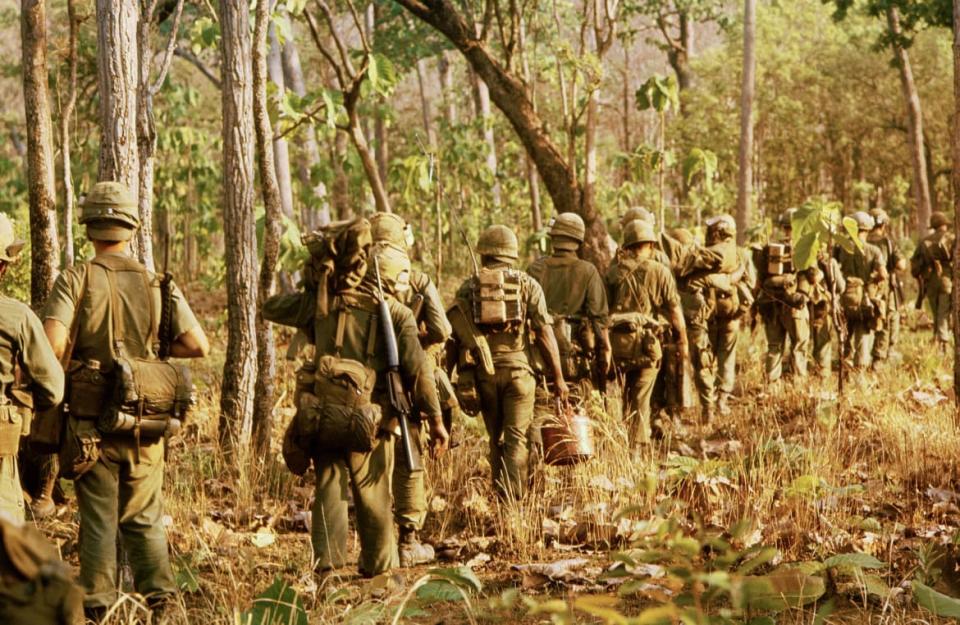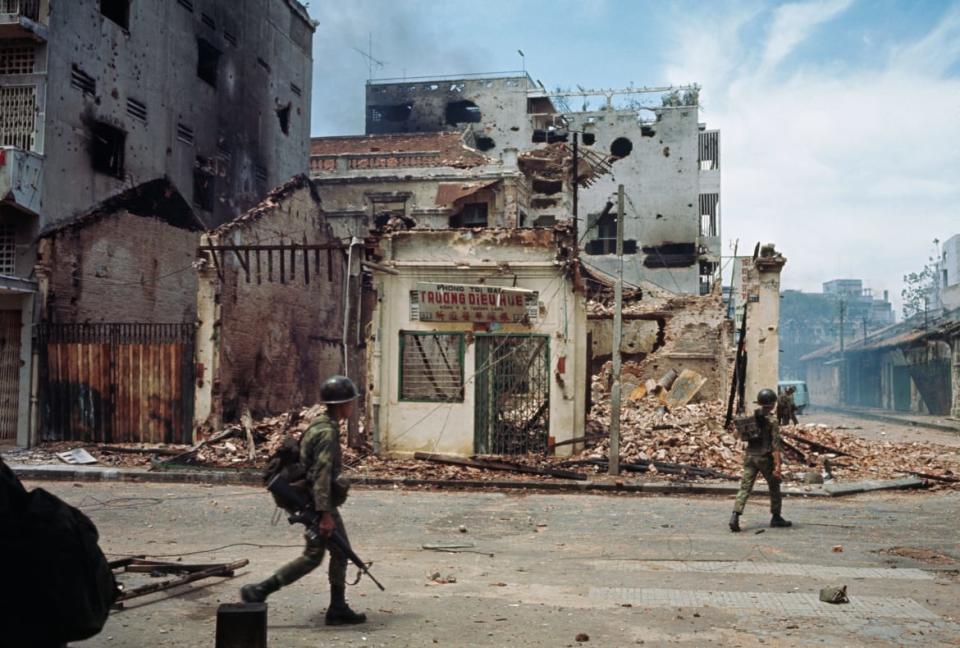How Arrogance and Ignorance Doomed the U.S. in Vietnam

In 1965, the United States was widely regarded as the most powerful and prosperous nation on earth. The country was in the forefront of expanding the boundaries of democracy and free institutions abroad. Its military power was the chief bulwark against communist expansionism in Europe and Asia in the ongoing Cold War. The U.S. economy, along with Americans’ increasingly consumer-driven way of life, was the envy of much of the rest of the world. The American people, it’s fair to say, were by and large an optimistic and confident bunch. Their republic, almost 200 years old, had been tested in the annealing fires of a civil war, two world wars, a devastating depression, and most recently, by the assassination of a beloved president and war hero, John F. Kennedy.
By almost any measure, the United States appeared to be at the forefront of history. Yet beneath all the optimism and prosperity, there were unmistakable signs of racial and social turbulence, and even revolutionary change. The most visible and gripping struggle concerned Black Americans’ effort to obtain voting rights, equal justice under law, and access to the American dream. But young middle-class whites were becoming alienated and distrustful of “the establishment,” and women and gay people were beginning to question their secondary status in a supposedly open society.
U.S. Troops Say No Thanks to Thanksgiving in 1969 Vietnam
As 1965 began, President Lyndon Johnson and his chief advisers were increasingly preoccupied with a foreign policy crisis in a relatively small and obscure Southeast Asian nation called Vietnam. Few Americans could have found Vietnam on a world map in early 1965, but Washington had committed itself a decade earlier to preventing a powerful communist insurgency in South Vietnam from crushing the beleaguered pro-American administration in Saigon and uniting South Vietnam with North Vietnam under a single communist government.
By February 1965, Johnson had decided the only way to preserve South Vietnam’s independence was to commit United States ground forces to the fight against the insurgency in the South, and to launch a bombing campaign against the North Vietnamese, who both supported and directed that insurgency. The first Marines waded ashore on March 8 on Red Beach in Danang; the Army arrived in strength a couple of months later, along with a vast number of contractors, engineers, and civilian construction companies to transform Vietnam’s underdeveloped infrastructure and prepare the country for a major American war. Airfields, all-weather roads, six major ports, and hundreds of bases and installations seemed to appear overnight.

General William C. Westmoreland
In July, President Johnson warmly approved Gen. William Westmoreland’s attrition strategy, which prioritized large-unit, search-and-destroy attacks by U.S. heliborne forces on the conventional, main force units of the Vietcong and North Vietnamese Army, but left the fight against the Vietcong political infrastructure in the villages—the beating heart of the struggle—to the South Vietnamese forces.
With a force of 44 combat battalions and a total of 175,000 American troops, Westmoreland said he could blunt the considerable momentum of the insurgency by the end of 1965 and stabilize the military balance. In Phase 2 of the campaign, from January to June 1966, U.S. forces would go on a sustained offensive, requiring the deployment of an additional 24 combat battalions and supporting forces for those units. The combat battalions would “find, fix, and destroy” enemy main force units in the mountainous hinterlands of the Central Highlands, along the coastal villages of the northern part of the country, and in the major VC base camps surrounding the capital, Saigon. American infantry would both locate and engage enemy main forces, but most of the killing would be done through the immense firepower that supporting arms—artillery, aircraft, and naval gunfire—could bring to bear.
By the end of the 1966 offensive or soon thereafter, Westmoreland projected, the war would likely reach a crucial “crossover point,” where the communists would be taking more casualties per month than they could replace on the battlefield. Once Hanoi reached that grim plateau, Westmoreland reckoned, its will to continue taking punishment would weaken and then break. At that point, “mop-up” operations would begin. It might take another year or so to finish off the enemy—for good. Such was the plan.
In mid-November, deep in the Central Highlands, the North Vietnamese and American armies clashed for the first time in one of the most dramatic and vicious battles in American military history: the Battle of the Ia Drang. There, one American battalion was almost annihilated, but prevailed against heavy North Vietnamese assaults for three days. Another U.S. battalion was completely destroyed in a vicious communist ambush. American losses were 304 dead and 524 wounded. The Army claimed to have killed more than 3,500 Vietnamese, but a more realistic figure, factoring in the American penchant for casualty inflation, would be 2,000. Westmoreland looked at the numbers and declared the battle a great victory that confirmed the soundness of his strategy. “We’ll just go on bleeding them dry until Hanoi wakes up to the fact that they have bled their country to the point of national disaster for generations,” said America’s senior field commander a bit later in the war.
Trouble was, Westmoreland had misread the battle, as well as the war of which it was a part.

Engineers from the 173rd Air Cavalry make their way through forest on Chu Phong mountain, in the Ida Drang Valley. Vietnam, 1965.
The crossover point was a fatally flawed strategic idea. It failed to take account of several pivotal variables, such as the enemy’s ability to limit his own casualties by avoiding battle, the strict limits imposed on American combat operations imposed by Washington, and North Vietnam’s demographics at the time. Johnson prohibited American forces from attacking communist formations in Laotian and Cambodian sanctuaries. He ruled out a ground invasion in Vietnam. Over 200,000 North Vietnamese men came of military age each year. Hanoi was willing to take casualties on a scale no Western democracy could sustain in individual battles, but it could also control its rate of losses simply by avoiding big-unit combat, and indeed, it did so at various junctures throughout the remainder of the war.
Under these strictures, no army on earth, not even the U.S. Army, was going to bleed the communist forces dry.
Although all the senior players knew that the conflict in Vietnam ultimately hinged on the South Vietnamese government’s ability to gain the loyalty and respect of the people in the villages, the Americans decided to leave that job to the South Vietnamese army and militia, even though the militia was small and undertrained and the Army was a dysfunctional institution, riven by corruption and political intrigue. Westmoreland’s way of war—the U.S. Army’s preferred way of war—did inflict ghastly casualties on the forces of the revolution, but it also destroyed hundreds of villages, and drove several million Vietnamese peasants from their ancestral homes to slums outside of Saigon, Danang, and other the urban centers. Once the American war machine was in full gear, as it was by early 1966, it began to shred the social fabric of the country it was supposed to be saving.
Nor did Westmoreland give any indication that he took the enemy’s ingenious protracted war strategy seriously. North Vietnamese General Vo Nguyen Giap, the chief author of that strategy, often remarked that American military forces were far superior to his own by virtually every measure. Nonetheless, he believed that Americans’ strategic assessments of the nature of the war, of their own strengths and weaknesses and those of their adversaries, were markedly inferior to those of Hanoi and the National Liberation Front that controlled most of South Vietnam’s 2,500 villages. Through the NLF, Hanoi effectively integrated a cluster of political and military initiatives to build up the strength of its shadow political infrastructure in the villages, while simultaneously frustrating the efforts of Saigon to do the same.
The essence of Giap’s protracted war strategy, writes Douglas Pike, one of its most perceptive students, was “people as an instrument of war. The mystique surrounding it involved organization, mobilization and motivation of people… Violence is necessary to it but not its essence. The goal is to seize power by disabling the society, using special means, i.e., assassination, propaganda, guerrilla warfare mixed with conventional military operations, chiefly organizational means. In fact, organization is the great god of Vietnam’s protracted war strategy and counts for more than ideology or military tactics.”
The communists’ strategy in the American war can be conceived of as a kind of bear trap. The two “jaws” of political struggle and military struggle close in on the enemy, constricting his room for maneuver and response, inflicting psychological and physical punishment on him, and gradually sapping his morale as well as his material resources. The role of the Communist Party leadership is to adjust continually the ratio of resources devoted to each type of struggle over time and space, as circumstances develop. Everything hinges on the caliber of the strategic assessments behind the adjustments.
Neither form of struggle can be effective in isolation. It is only when the two are properly combined—what Pike calls “the marriage of violence to politics”—that success can be achieved.
The regular North Vietnamese and Vietcong forces may not have beaten the Americans in big unit battles, but they were able to inflict sufficient casualties on the United States to force millions of Americans back home to begin to think critically about what Washington was doing in their name in Vietnam. Moreover, the followers of Ho Chi Minh and his movement—farmers, factory workers, porters, soldiers, political cadres, and Vietcong agents who worked on U.S. and South Vietnamese Army bases—were able to frustrate America’s crucial military and political objectives without winning any big battles. By continuously expanding and improving the Ho Chi Minh Trail, and by deploying large numbers of troops in Cambodia and Laos, the North Vietnamese defeated the pivotal American effort to isolate the battlefield. Despite an ambitious and sustained air interdiction campaign by the U.S. Navy and Air Force to cut the Trail, the numbers of troops and tonnage of supplies brought into the South increased virtually every month between 1965 and 1968.

Military personnel walk among destroyed buildings and empty streets following heavy fighting, part of the Tet Offensive operations of the Vietnam War, in the Cholon district of Saigon (now Ho Chi Minh City), South Vietnam, June 6, 1968.
The audacious Tet Offensive of Jan. 31, 1968, in which every major city, town, and many key military installations in South Vietnam came under simultaneous communist attack, was something of a tactical disaster for Hanoi and the NLF. The communists were driven off most of their objectives within a week, and all the rest within a month. But Tet’s crucial objective wasn’t to gain and hold territory. Rather, it was to inflict a devastating blow on the American public and its government by exposing the bankruptcy of America’s strategy. It succeeded. For the United States, Tet “was a long-postponed confrontation with reality,” writes historian Gabriel Kolko. “It had been hypnotized until then by its own illusions, desires, and needs. The belated realization that it had military tactics and technology but no viable military strategy consistent with its domestic and international priorities made Tet the turning point in the [Johnson] administration’s calculations.”
The most shocking thing about Westmoreland’s strategy for fighting the war was not that it was wrongheaded at the outset, but that neither he nor his superiors in Washington made a serious attempt to revise their approach to the conflict as evidence mounted in 1966 and 1967 that America was losing the Vietnam War.
“The first, the supreme, the most far-reaching act of judgment that the statesman and commander have to make,” famously wrote the great philosopher of war, Carl von Clausewitz, “is to establish… the kind of war on which they are embarking; neither mistaking it for, nor trying to turn it into, something that is alien to its nature.” From the vantage point of more than 50 years, it’s difficult to quarrel with the idea that senior officials, from Johnson and Westmoreland on down, gravely misjudged “the kind of war on which they were embarking” in 1965. It’s clear that neither Lyndon Johnson nor General Westmoreland was able to grasp that the crisis in Vietnam was not fundamentally a Cold War, East-West confrontation, but a complicated civil conflict between Vietnamese, in which communist-led revolutionaries with impeccable nationalist credentials were locked in conflict with a Saigon regime with pitifully weak ones. And those credentials were made weaker still by the infusion of U.S. military forces in 1965, and the inevitable takeover of management of the war by Washington from Saigon.
Since the 1970s Westmoreland has often been singled out by historians and journalists as both largely responsible for, and a symbol of, American defeat. This seems unfair, now that almost half a century has passed since the war’s end. The more we come to know about the conflict in Vietnam, the less likely it seems that any American general, or any particular military strategy, could have prevented the fall of South Vietnam to Hanoi. Could the United States have waged a well-executed counterinsurgency strategy, given the American people’s notorious impatience for concrete results when their troops are fighting and dying? Could the South Vietnamese political and military leaders have somehow escaped their fractiousness and dysfunction?
No one knows the answer to either question for sure, and no one ever will. My best guess, having studied the conflict for many years, is that the answer to both questions is a simple “no.”
From Vietnam to COVID-19, the Arrogance of Ignorance Keeps Killing Americans
The United States made many mistakes in fighting the war in Vietnam. But the mother of them all was deciding to fight with its own ground forces there in the first place. The dangers inherent in that decision, of course, were not lost on quite a few knowledgeable people both inside and outside the administration during the early part of the war. Look, for instance, at this remarkably perceptive analysis of April 1965 by Harold P. Ford of the CIA, written just as the U.S. Marines were granted permission to go on offensive operations against the Vietcong for the first time:
This troubled essay proceeds from a deep concern that we are becoming progressively divorced from reality in Vietnam, that we are proceeding with far more courage than wisdom—toward unknown ends. There seems to be a congenital American disposition to underestimate Asian enemies. We are doing so now. We cannot afford so precious a luxury. Earlier, dispassionate estimates, war games, and the like, told us that [the communists in Vietnam] would persist in the face of such pressures as we are now exerting on them. Yet we now seem to expect them to come running to the conference table, ready to talk… The chances are considerably better than even that the United States will in the end have to disengage from Vietnam, and do so considerably short of our present objectives.
Many, many of the best-informed people on the situation in Vietnam, including the vice president, Hubert Humphrey, and the father of America’s strategy of containment, the diplomat George F. Kennan, thought Ford’s view was spot on, as it was.
Of course, neither American strategic blunders nor South Vietnam’s deficiencies fully explain the war’s astonishing outcome. Hanoi and the NLF emerged victorious in large measure because they instilled hope and commitment in millions of ordinary Vietnamese that the communist-led revolutionary movement was the best route to a united, independent Vietnam, free from domination by foreign powers. The feckless government of South Vietnam inspired few of its own people and even fewer outsiders; the NLF inspired millions, despite the harshly repressive nature of the regime that controlled it in the North.
One of the crucial lessons of the war, historians now widely agree, is that it is beyond the capability of the United States to remake other nations in its own image, and morally wrong to try. To use American power to alter fundamentally the politics and history of a nation like Vietnam, about which senior American policymakers were profoundly ignorant, was to invite disaster, and disaster is what befell them. Chastened by the searing experience of Indochina, American presidents refrained from committing the country to ambitious foreign adventures in the last quarter of the 20th century, for the most part.
Sadly, in the emotionally supercharged wake of the Sept. 11, 2001, terrorist attacks on the twin towers and the Pentagon, Washington forgot this hard-won lesson, and tried to create pro-Western states in both Afghanistan and Iraq, countries U.S. policymakers knew even less about than their predecessors knew about Vietnam. Those wars have not had as dramatic an impact on American society as Vietnam, but they, too, were failed crusades, and for many of the same reasons that obtained in Vietnam in the 1960s.
Out of fatal combination of ignorance and arrogance, the Bush administration underestimated the enormity of the projects it undertook in both Afghanistan and Iraq; the resilience and strength of its adversaries, and the political liabilities of our local allies. Like Johnson and Westmoreland, the Bush team blithely assumed that America’s unrivaled military power, with a little help from the diplomats, could get the job done.
The assumption proved to be wrong. Disastrously wrong, and very costly in blood and treasure.
This essay is adapted from Year of the Hawk: America’s Descent into Vietnam, 1965, by James A. Warren, published by Scribner.
Get the Daily Beast's biggest scoops and scandals delivered right to your inbox. Sign up now.
Stay informed and gain unlimited access to the Daily Beast's unmatched reporting. Subscribe now.

 Yahoo Movies
Yahoo Movies 